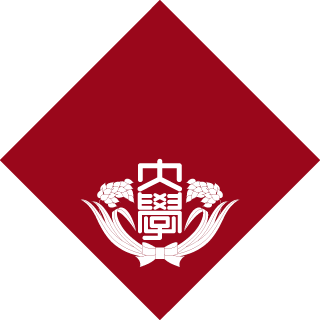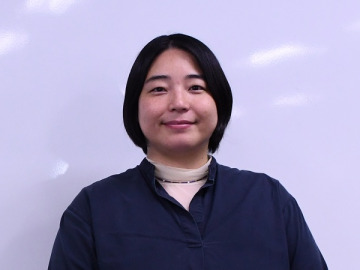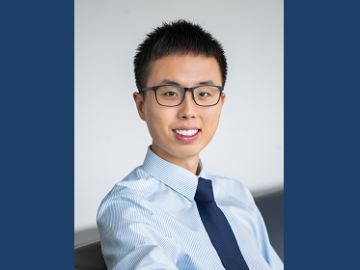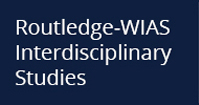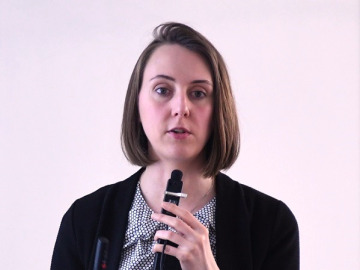
BRADEL Sabine Sophia, Assistant Professor
My research examines the works, careers, and networks of ukiyo-e artists active during the mid-Edo period (1603-1868), who are often overlooked in the histories of art due to the prevailing emphasis on technological innovation in that era. The genre of ukiyo-e is an ideal subject for this type of study for two reasons. First, the way we understand and discuss ukiyo-e is deeply ingrained in their global reception history since the mid-nineteenth century; secondly, the Eurocentric discourse that subsequently developed in Europe and North America has since affected the study of early modern Japanese art in general.
This Eurocentric discourse often associates “innovation” with technological changes. In the case of ukiyo-e, this notion of innovation is particularly concerned with changes in colour woodblock printing. Usually, “innovation” is linked with a specific moment in time and attributed to a particular artist, who is then highlighted as the leading figure of that era. However, innovation is rarely a spontaneous phenomenon but typically results from a longer process that builds on the contributions of many individuals. Yet the achievements of artists not immediately associated with “innovation” have sometimes been overshadowed by the prominent names of the so-called “innovators,” even when these individuals were not the sole creators of that innovation. Additionally, not all artists may have had immediate access to this “innovation,” nor was it necessarily affordable for all consumers of that art form.
A prime example of this innovation-centric perspective in the historiography on early modern Japanese art is the transition from reduced-colour printing (benizuri-e 紅摺絵) to full-colour printing (nishiki-e 錦絵) around 1765. This shift is often discussed exclusively in relation to the single-sheet prints designed by Suzuki Harunobu 鈴木春信 (c. 1725-1770), the first artist to employ this technique on a larger scale, due to the private sponsorship of wealthy patrons. However, Harunobu had been part of a broader network of artists, whose contributions to this transition are frequently eclipsed by his prominent status. Therefore, by looking beyond this innovation-centric discourse and focusing on the artists who continued to work with established techniques, it becomes possible to, firstly, trace the achievements that paved the way to innovation; secondly, identify potential misattributions to “innovators”; and thirdly, gain a deeper insight into the environment in which ukiyo-e prints were created and consumed in the mid-eighteenth century.

Left: Torii Kiyomitsu I. The Actor Segawa Kikunojō II as the nun Seigen, c. 1762, benizuri hashira-e. Art Institute of Chicago, Clarence Buckingham Collection (1925.2843), Creative Commons Zero (CC0) Public Domain.
Right: Suzuki Harunobu. The Actor Segawa Kikunojō II as the nun Seigen, c. 1763, benizuri hashira-e. Art Institute of Chicago, Clarence Buckingham Collection (1925.2762), Creative Commons Zero (CC0) Public Domain.
The history of ukiyo-e in a global context
Ukiyo-e is also known as “pictures of the floating world (ukiyo-e 浮世絵)” as its imagery depicts the fleeting joys of life in urban centres, particularly Edo (present-day Tokyo). The main subjects include seasonal festivities, fashionable citizens, and the stars of the kabuki theatre. In the Edo period, the history of ukiyo-e was mainly recorded through artist biographies, such as Various Thoughts on Ukiyo-e (Ukiyo-e ruikō 浮世絵類考) written by Ōta Nanpo (1749-1823) between 1790 and the early 1800s, and updated several times throughout the Edo period by prominent members of the “floating world.” However, the discourse on ukiyo-e as it is conducted today developed in Europe and North America during the 1870s, when Japanese artworks received increasing attention through their exhibition at the annual World’s Fairs. Artists, collectors, and scholars alike were captivated by the vivid colours and compositions of ukiyo-e, which contrasted sharply with the established conventions of the national art academies. This enthusiasm inspired the avant-garde movement known as Japonisme as well as the first comprehensive studies of ukiyo-e and its history. However, as the authors of these studies often lacked the methods and vocabulary to interpret non-European art, they relied on established art academic systems of evaluation.
As a result, ukiyo-e, like all other art forms, were classified according to a conception of progression that evolved on the basis of the historiographical approaches of Giorgio Vasari (1511-1574), Johann Joachim Winckelmann (1717-1768), and Georg Wilhelm Friedrich Hegel (1770-1831). In this progression, each new phase begins with an “innovation” that becomes the standard until the next “innovation” heralds the subsequent phase. It begins with a phase of “emergence,” which, from the historiographer’s perspective, is also referred to as “primitive” due to its perceived unrefined style and production methods. This phase subsequently evolves into a “classical” period, reaches a “Golden Age,” and eventually declines into “decadence.”
This system was adopted in Japan when art history was established as an academic discipline in the late nineteenth century. Consequently, when Japanese scholars began to add their voices to the global discussion of ukiyo-e, they formulated their interpretations along the lines of Euro-American scholarship. This created a mutual citation cycle that highlighted the same group of artists associated with innovation, while bypassing those who continued to work in established methods and styles. Although the terminology has since changed, with the history of ukiyo-e now being divided into an “early,” “middle,” and “late” period, and with artists previously considered “primitive” or “decadent” being recognised for their skilful compositions that made the most of the technology available at the time, the canon of artists established on this foundation has largely remained the same.
Background and scope of the study
The pitfalls of this innovation-centric perspective first became apparent to me when I began studying the works of Suzuki Harunobu as a graduate student specialising in Japanology and Euro-American art history. Harunobu was the first artist to employ the new and costly full-colour (nishiki-e) technique on a larger scale, presumably monopolising it for three years with the support of wealthy patrons. His hundreds of playful compositions, which depict handsome citizens while cleverly alluding to established historical and literary tropes through hidden patterns and elements, have led to his recognition in ukiyo-e history as one of its greatest innovators. These nishiki-e are also the focus of most Harunobu scholarship, and I, too, was captivated by them. However, Harunobu actually began his career with benizuri-e prints of kabuki actors and monochrome illustrated books. These two media were previously considered “primitive,” and consistently characterised in the innovation-centric discourse as “inconsequential” or “undistinguished.” I therefore began to wonder why such an artist was granted the exclusive access to nishiki-e printmaking.
This question drove my dissertation project in East Asian art history, in which I examined the works Harunobu published during the five years from his debut in 1760 to the onset of the nishiki-e period in 1765. By investigating his career-building strategies and networks, which ultimately connected him with the patrons who sponsored his nishiki-e prints, I illuminated the rarely studied commercial environment in which Harunobu operated during the early years of his career, and which significantly affected the way he created his compositions. It thus became evident that several stylistic and formal “innovations” commonly attributed to Harunobu were not necessarily his individual creations. Rather, they were part of a broader trend that had emerged in the years preceding his debut and were utilised by multiple artists.
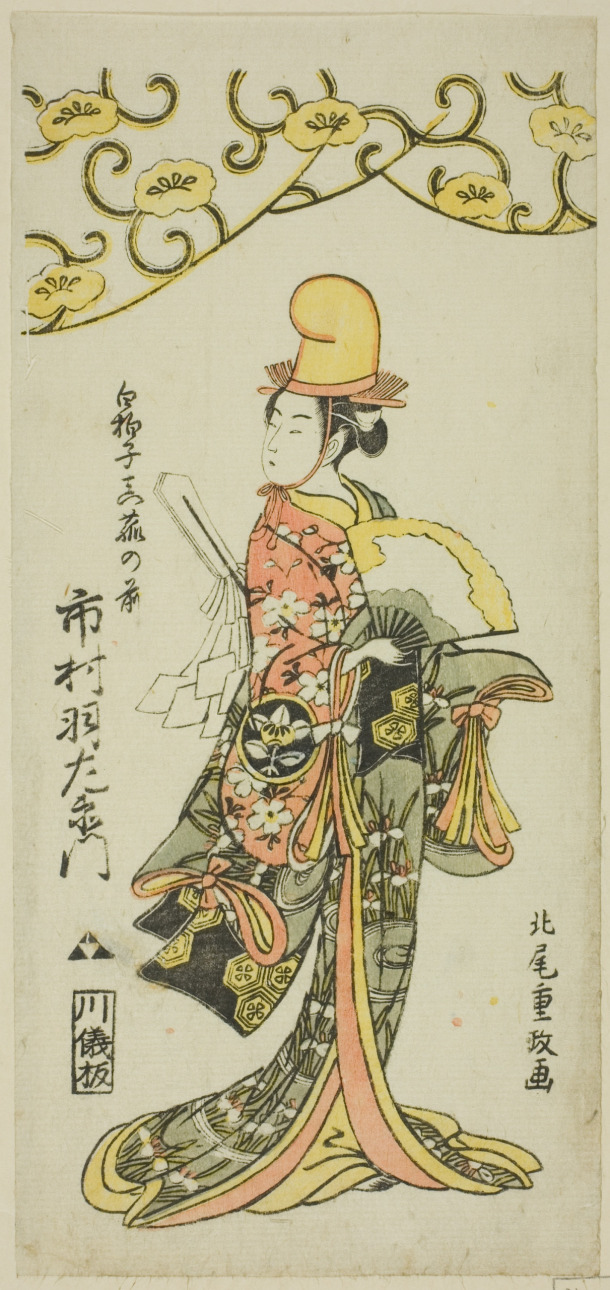
Kitao Shigemasa. The Actor Ichimura Uzaemon IX as shirabyōshi dancer Makomo no Mae in the jōruri “Iru ni Makase Yumiharizuki,” performed at the Ichimura Theater in the eleventh month, 1767, 1767, hosoban benizuri-e. The Art Institute of Chicago, Clarence Buckingham Collection (1928.892), Creative Commons Zero (CC0) Public Domain.
The predominant focus on Harunobu has overshadowed not only the achievements of these earlier artists but also the careers of those who made their debut at the same time as Harunobu and pursued similar paths. Consequently, it remains unclear how these artists continued their careers in the years of Harunobu’s supposed monopoly on nishiki-e printmaking. In the histories of ukiyo-e, they either reappear after several years with nishiki-e of their own or seem to have abandoned printmaking altogether, as there are no further records of them. Moreover, due to the high production costs, nishiki-e prints were initially luxury products created for a limited number of people, and these prints only gradually transformed into a marketable commodity. Likewise, the number of commercial publishers who were able to invest in the new technology, those who continued to use the previously common benizuri-e technique, and those who went bankrupt while trying to meet the rising demand for nishiki-e while struggling with the high production costs have also received infrequent attention. The impact of the high prices of early nishiki-e production on print buyers has similarly received little consideration.
Based on these questions, my research at WIAS examines the production of ukiyo-e through the lens of “continuity” rather than “innovation.” I thus seek to illuminate the careers of artists who paved the way for nishiki-e printmaking, as well as the historical context of early nishiki-e production within the broader history of ukiyo-e. By engaging in the interdisciplinary environment of WIAS and supported by the excellent research resources at Waseda University, I aim to contribute to a more comprehensive understanding of the history of ukiyo-e.
